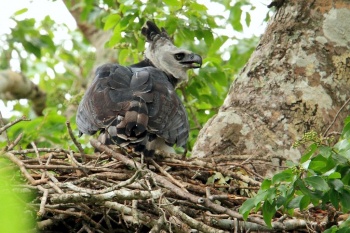- Harpia harpyja
Identification
89–105 cm; 10 pounds(4.5kg)
The Harpy Eagle is heavy, but not the heaviest of eagles, and its wing-span too is exceeded by many others. What does mark it out from all other eagles,however is the immense size of its feet and talons, and the great girth of its legs.
- Greyish head
- Dark, divided crest
Distribution
Central and South America: very rare in Mexico reported from Veracruz, Chiapas and Campeche, also from Belize and Guatemala south to Panama and in South America from Colombia, Venezuela and the Guianas south to south-east Brazil and north-east Argentina.
Taxonomy
This is a monotypic species[1].
Habitat
Primary rainforest, at 100 to 1,800m. Occasionally soars over forest and sometimes perches on the highest treetops but spends much time in dense canopy foliage.
Behaviour
Diet
Their diet includes big animals such as sloths and howler and capuchin monkeys.
Breeding
The nests are situated at a great height in the crowns of silk cotton trees, about 165 feet (50m) above the ground. Made of sticks up to 1.6 inches (4cm) thick,the nest is 5 feet (1.5m) across and lined with green leaves and animal hair.Two eggs may be laid,but it is normal for only one young eagle to be reared.
Vocalisation
Call: a loud wailing wheeeeeee or wheeeeoooo.
Movements
A resident species.
References
- Clements, J. F., T. S. Schulenberg, M. J. Iliff, D. Roberson, T. A. Fredericks, B. L. Sullivan, and C. L. Wood. 2014. The eBird/Clements checklist of birds of the world: Version 6.9., with updates to August 2014. Downloaded from http://www.birds.cornell.edu/clementschecklist/download/
- Handbook of the Birds of the World Alive (retrieved February 2015)
Recommended Citation
- BirdForum Opus contributors. (2024) Harpy Eagle. In: BirdForum, the forum for wild birds and birding. Retrieved 21 May 2024 from https://www.birdforum.net/opus/Harpy_Eagle
External Links






